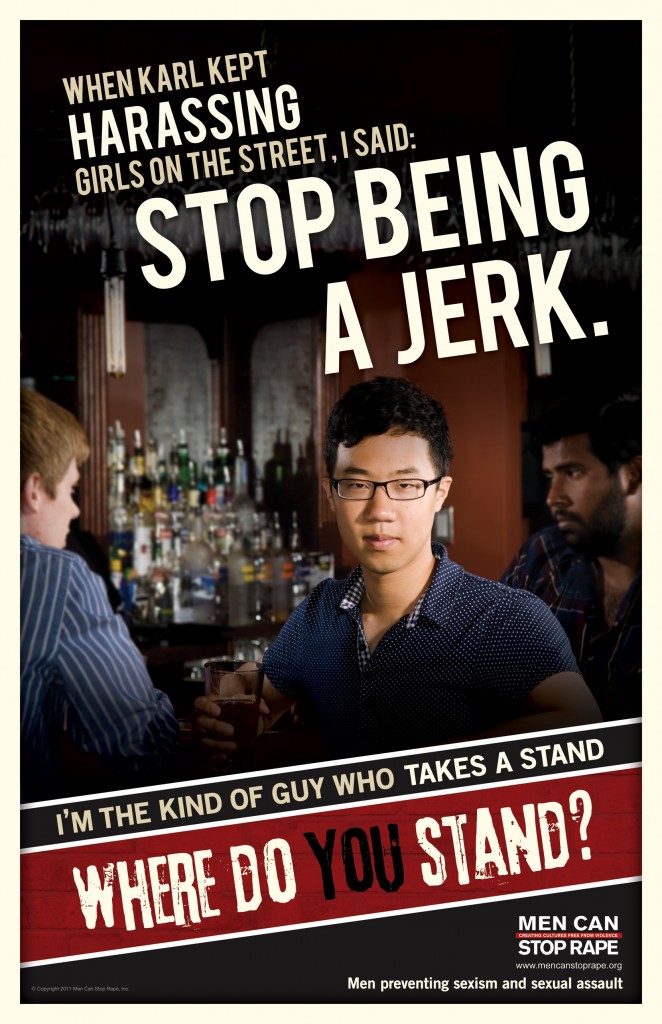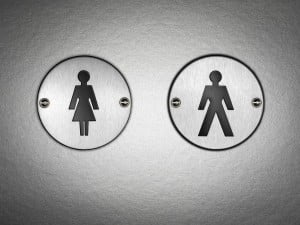
Credit: Men Can Stop Rape
It’s pretty common for us to worry about how women, especially our own daughters, are put into gender boxes and encouraged to engage in behavior that hurts them, simply because they’re female.
It’s far less common for us to worry about men, including our own sons, and what gender boxes and harmful behaviors they’re taught, simply because they’re male.
But they are. Boys as young as 4 year old are told to “be a man!”, usually in response to them crying or showing fear.
And as they grow up, they’re bombarded with messages that say to be a “manly” man, they need to:
- Be big and strong
- Be physically aggressive and ready to fight
- Show no emotions – especially fear or pain but anger is just fine
- Feel entitled to objectify women and sexually pursue women regardless of whether or not she’s interested
You only need to look at our thousands year old history of warring groups that pillaged, looted, and raped to see where this dominant idea of masculinity comes from.
It doesn’t take a leap of faith to see how this history has led to our society and media promoting images of masculinity as inherently obsessed with fighting and sex.
And then having some men turn that image into a reality where they feel entitled to be assault and dominate others, particularly women.
Yet we seldom hear about how this male violence is connected to our traditional notion of masculinity.
And at the same time, while most violent acts are committed by men, most men are NOT violent.
So many men are caring, responsible, and non-violent people. But while many men don’t use violence to express their feelings or control others, many don’t feel comfortable showing the other sides of them for fear of being called “gay”, “girly”, “soft,” or “emotional”.
That’s why we need to change the conversation around masculinity. We need the definition of masculinity to reflect the diversity present in men beyond the narrow box they have now.
Not only to reduce the level of male violence but to also support men in accepting all parts of themselves and expressing themselves fully – without being shamed.
One organization fighting to do just that is Men Can Stop Rape. Through their Men of Strength Clubs (MOST Club), they have pioneered a violence prevention program that provides young men in middle school, high school, and college with a structured and supportive space to build individualized definitions of masculinity that promote healthy relationships.
Based on their highly effective program, here are some ideas of how to talk with your son and other men in your life about what masculinity means for them and its relationship to their lives and violence.
1. Meet Them Where They’re At
Many men may not have thought critically about how society portrays masculinity. It may be assumed to just be normal – that this is just part of being a man.
So they may not see why it’s something important enough to discuss. At the same time, many men may be uncomfortable with how they are represented in the media and don’t identify with the beefy, fighting, womanizing men in the movies.
So it’s important to not assume anything about their beliefs, make them wrong, or attempt to change them. The point is not to create another narrow box for them to fit into but to expand the choices they have and support them in exploring what masculinity is aligned with their values.
2. Help Them To Identify Male Role Models They Know
While the media may glorify violent men, in real life, they are usually not the ones we admire. Men who are responsible, empathetic, caring, and contribute to the community are usually admired.
Ask them how these men show strength in their relationships and how they treat people. Helping them to see how the men they respect do not fit this traditional notion expands their understanding of masculinity and gives them more options.
For many, this may be the first time they’ve thought consciously about how strong good men they respects do not fit that mold.
3. Discuss How the Media Presents the Ideal Man
The media is filled with portrayals of fictional male characters who are primarily rewarded for fighting and getting the girl.
Ask him how this affects his idea of how men should act and compare it to how men he respects act. Often times men haven’t really compared the two and hear the traditional notion much more strongly to the point where they don’t see other ways of being a man.
4. Discuss How Traditional Masculinity Shows Up In Their Own Behavior
While many men are not violent, traditional masculinity encourages other behaviors that are normalized in our society, such as street harassment, a sense of sexual entitlement, use of physical intimidation over smaller people, etc.
So it’s important for them to connect the dots between more violent acts and more socially sanctioned behaviors stemming from male domination. The more aware they are about their own behavior, the more they can choose whether or not they want to continue doing it.
5. Discuss the Role of Traditional Masculinity in Violence, Particularly Against Women
Since they have been socialized to think traditional masculinity is the ideal, it can take time for them to connect it with something they’re against like violence. So work backwards and discuss what can lead a man to feel comfortable with becoming violent.
While traditional masculinity does not necessarily always lead to violence, it does support male domination over others. And this creates a permissive culture where “boys will be boys”, “he can’t control himself sometimes”, and “she was asking for it”.
6. Discuss How Nonviolent Men Can Be a Part of Ending Violence
Many men who are not violent think that because they’re not doing it, that’s enough. But that should be the floor and not the ceiling for men’s engagement in the efforts to end violence. Sharing statistics about domestic violence and sexual abuse with them can help them see that they probably know several women and men who have been abused but never knew.
Show them different ways they can be involved – whether it’s learning more about the issue, volunteering at nonprofits, or discussing it with their male and female peers – they can do something to stop the violence.
These discussions aren’t easy. In fact, they can be extremely tricky and you may find yourself judging him or getting upset at different times.
So remember, you’re challenging years of society and media telling them what a “man” is. These concepts run deep on the subconscious level and by even engaging in the conversation, they’re taking a big step.
And more importantly, remember that it’s not your place to tell them they’re wrong and make them agree with what you believe “masculinity” means either. That would be the same type of domination you’re trying to eradicate!
But keep challenging their ideas in service of them engaging in their own critical thinking process about what type of man they want to be. Your goal is to help them see other options so they can consciously make their own decision for themselves.
[do_widget id=”text-101″]
This article was written in collaboration with Men Can Stop Rape, an international organization whose mission is to mobilize men to use their strength for creating cultures free from violence, especially men’s violence against women. MCSR provides agencies, schools, and organizations with direct services for youth, public service messaging, and leadership training. Follow on Facebook or Twitter.
Sandra Kim is the Founder & Executive Director of Everyday Feminism. She brings together her personal and professional experience with trauma, personal transformation, and social change and gives it all a feminist twist. To book her for speaking engagements, click here!
Search our 3000+ articles!
Read our articles about:
Our online racial justice training
Used by hundreds of universities, non-profits, and businesses.
Click to learn more
Most Read Articles
- « Previous
- 1
- …
- 30
- 31
- 32



















